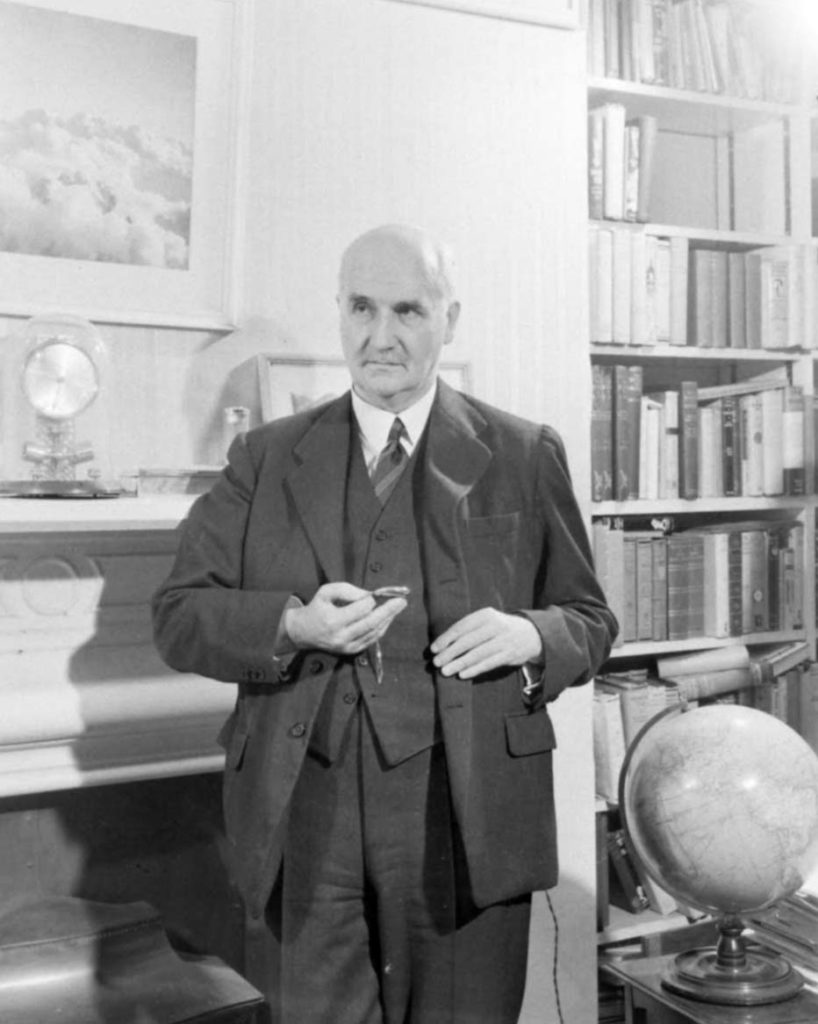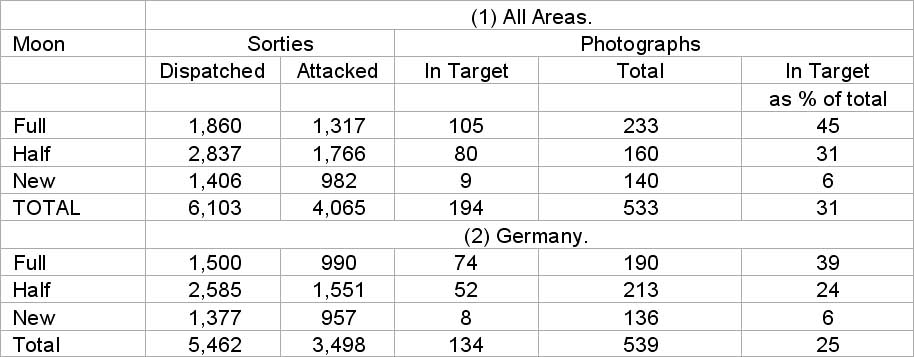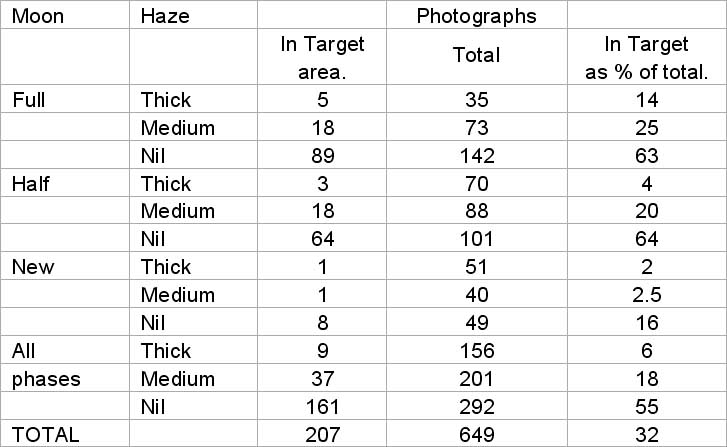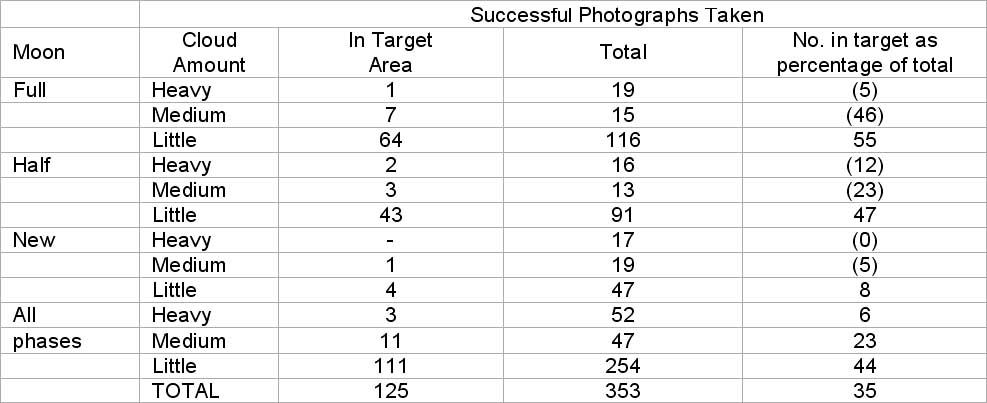
The Butt Report is a product of Lord Cherwell’s “S-Branch”, the office responsible for condensing statistical data into short briefs for the PM.
My thanks to Mr. William Thomas for his work in transcribing this important piece of history:
Report by David M. Bensusan-Butt, 18 August 1941, AIR 8/1356 – Bomber Command: Night Photograph Analysis, AIR 8 – Air Ministry and Ministry Defense: Department of the Chief of the Air Staff: Registered Files, Records of the Department of the Chief of the Air Staff, AIR, National Archives (UK).
Pictures shown are purely for educational purposes and no permission has been sought. Blue characters are additions and corrections I have made to the transcript. If any mistakes are found, please let me know by contacting me here.
Offices of the War Cabinet Great
George Street, S.W.1
18th August, 1941
Dear Wing-Commander [Lewin Bowring Duggan],
I attach the report on the work I have been doing in the past fortnight. It is, I am afraid, very lengthy, but the summary on top will perhaps be of assistance.
You will see that I have not attempted any study of the day photographs or of comparative damage in German and British towns. This was partly because the time at my disposal was not long enough, but mainly because to be done properly the work requires skill at interpreting photographs and technical knowledge of bomb damage, neither of which I possess. But as mentioned in the last part of the report I very much hope that this job will get done by those suitably qualified. I can, however, record a definite impression – not more – that such a study would give results consistent with those I reached.
If there are points about this report which you would like me to amplify perhaps you would be kind enough to give me a ring here. I can be obtained via the Air Ministry, Whitehall, switchboard. In the evenings I am usually at Marlow 487 and could easily get over to see you.
I cannot end without thanking you and all the other officers at Bomber Command whom I saw, and particularly those of the Photographic Interpretation Section, for their kindness and patience. You made my stay most enjoyable and I only hope in return that I have been of some use.
Yours sincerely,
/s/
[David Miles Bensusan-Butt]
Wing-Commander Duggan
Bomber Command,
Via Air Ministry.
MOST SECRET
SUMMARY
STATISTICAL CONCLUSIONS.
An examination of night photographs taken during night bombing in June and July points to the following conclusions:
- Of those aircraft recorded as attacking their target, only one in three got within five miles.
- Over the French ports, the proportion was two in three; over Germany as a whole, the proportion was one in four; over the Ruhr, it was only one in ten.
- In the Full Moon, the proportion was two in five; in the new moon it was only one in fifteen.
- In the absence of haze, the proportion is over one half, whereas over thick haze it is only one in fifteen.
- An increase in the intensity of [AAA] fire reduces the number of aircraft getting within 5 miles of their target in the ratio three to two.
- All these figures relate only to aircraft recorded as attacking the target; the proportion of the total sorties which reached within five miles is less by one third.
Thus, for example, of the total sorties only one in five get within five miles of the target, i.e. within the 75 square miles surrounding the target.
RECOMMENDATIONS
- These results though fairly reliable should be checked by a thorough expert study of the day photographs, and by a comparative study of photographs of German and British towns.
- In order to keep these figures up to date, and to obtain continuous records of the success of air our navigation, staff should be set up to maintain statistical records of night photographs and any other evidence that may be available.
- This staff should consist of at least one trained statistician, with sufficient clerical staff. He should have authority to modify forms and questionnaires in order to make sample [inquiries], e.g. to replace some existing questions for a certain period by others designed to elucidate some particular point.
-1-
I. NIGHT PHOTOGRAPHS IN JUNE – JULY 1941
A Statistical Analysis
1. Particulars sufficient for some rough statistical analysis have been collected for about 650 photographs taken during night bombing operations between 2nd July and 25th July. They relate to 28 targets, 48 nights, and 100 separate raids. All show enough ground detail for the position photographed to be plotted if previous photographs of the area exist.
Nearly half of these photographs were taken independently of bombing, but as in all these cases the position believed photographed was named, they are equally useful for measuring the accuracy of navigation and have been included. (*The separate figures are available and yield almost exactly similar results)
The technique of taking night photographs is such that the area photographed is not necessarily the same as the area intended to be photographed. Changes of speed, height and direction, and any tilting of the aircraft will affect the result, as will delay in launching the flash. But the displacement is most unlikely to be more than a mile or two miles on a photograph which normally shows an area of over a square mile. As for the purpose of this [inquiry] the “target area” is taken as the area within five miles of the aiming point, the possibility of error in the results from this source is allowed for. There is no reason to suppose that more photographs intended for points in the target area actually show points outside than vice versa.
2. Success of attacks over period as whole.
The total number of photographs purporting to represent the target, target area, or believed target area for which details were obtained was 633. Of these 326 or 51% have not been plotted; 113 or 18% have been pinpointed outside the target area, and 194 or 31% within the target area.
The Photographic Interpretation Section are confident that all unplotted photographs must be outside the target area.
-2-
There seems no doubt that, in view of the [specialized] skill they have developed in examining some 750,000 prints, this claim is perfectly correct.
There is no reason to suppose that aircraft equipped with cameras are particularly unsuccessful. These 650 photographs were taken on over 500 different sorties; a sample of more than 1 in 10 of the sorties recorded as attacking during the raids covered.
The conclusion seems to follow that only about 1/3 of aircraft claiming to reach the target area actually reach it.
Prolonged consideration has revealed only one real possibility of error in this result. It may be that violent evasive action by aircraft will give rise to complete photographic failures and it may be that such action has to be taken particularly often within the target area. If so the results would be [biased]. It is difficult to say whether these conditions are fulfilled, but from the records of Command Photographic Officer it appears that some 75 intended photographs either failed to be taken or, if taken, to come out in the period concerned by reason of evasive action, searchlights and flak. It is most unlikely that these failures wholly occurred over the target area. Supposing, however, that they did, and that had they been taken all would have been successfully developed, about 700 photographs with about 275 in the target area would have been available, i.e. the percentage of 31 reached above would be raised to 39.
This figure represents the maximum possible consistent with the data. The rough ratio of 1/3 given above is more probable. Two qualifications to this average result should be made clear:
(a) This figure of one third (and all other percentages given in paragraphs (4) to (7) below) relate to the aircraft recorded as having attacked the primary target, not to the total aircraft [dispatched]. In the raids considered in this analysis, 6,103 aircraft were [dispatched] but 4,065 attacked, i.e. 66%. Thus the total [dispatched] not one third but one fifth reached the target area.
-3-
It must be observed also that by defining the target area for the purpose of this [inquiry] as having a radius of five miles, an area of over 75 square miles is taken. This must at least for any town but Berlin consist very largely of open country. The proportion of aircraft actually dropping their bombs on built-up areas must be very much less, but what this proportion is, however, cannot be indicated by the study of night photographs. Of the total [dispatched] not one third but one-fifth reached the target area.
3. Factors affecting the success of attacks.
The data collected enable some analysis to be made to indicate the importance of some of the main factors affecting this general percentage of success. In the following paragraphs, ground features, moon, haze, cloud and A.A. are considered. Attempts to measure the effects of wind changes and searchlights which are said to be very important factors broke down through lack of data.
4. Ground features.
Too few raids have been considered to allow any attempt to discover how easily any individual target can be found, but the following [figures] for groups of towns may be of interest.
-4-
Table 1.
Effect of Ground Features.

This table brings out very clearly the relative success with which French Ports (principally Brest) are reached, and it will be seen that had this group been excluded from the figures considered in section (2), it would have been necessary to reduce the figure of 1/3 for the success of attacking aircraft in reaching the target to 1/4.
These results are however considerably affected by the phase of the moon, e.g. only 1 of the 9 raids on French Ports were in the moon less-period against 11 of the 21 on German ports. Making rough allowance for this factor the following ratios are obtained:
| Germany (All Targets) | 100 | |
| French Ports | 215 | |
| German Ports | 125 | |
| Ruhr | 25 | |
-5-
The low figure for the Ruhr is presumably due to the prevalence of haze and smoke in the period covered and the absence of land marks.
5. Moonlight.
Defining the full moon period as the night of full moon and three nights before and after; and the new moon and half moon periods similarly, we obtain the following figures:
Table 2.
Effect of Moon.

It will be noticed that in the full moon period over all targets 45% of the successful photographs are of the target area, in the mid-moon 31%, and in the new moon 6%: percentages in the ratio of 15:10:2. When the figures for France are excluded all the percentages are of course reduced, but their ratios remain about the same.
6. Haze.
Ground haze and industrial smoke obviously have a very considerable effect on the success of attacks. To test this each of the forms rendered with photographs has been examined, and all references to haze have been classified into 3 groups:
-6-
(1) “Nil” or “slight” or “clear” etc.,
(2) “Some haze”, “hazy” etc., and
(3) “Thick haze”, “very hazy”, etc. (In view of the rather vague nature of the references to haze on the forms used, a separate calculation was made from the summaries on weather included in the Interceptions Reports of the Intelligence [Branch Headquarters Bomber Command], which are provided by the Meteorological Branch. These reports apply of course only to the weather of the whole raid and take no account of temporary changes at different times of the night, and in this respect perhaps give less precise information than the form accompanying the individual photographs. On the other hand they are prepared by experts. The results are not reproduced here, but they agreed very well.)
The moon phase has also been noted. The following results were obtained:
Table 3.
Effect of Haze.

Photographs are reckoned in this table against 633 in Table II. The extra prints were from photographs taken of alternative targets.
If we take the degree of success (say 60% – 70%) attained in full moon conditions with no haze as 100, the results for the 9 “states of visibility” may be [summarized] as follows:
-7-
Table 4.
Proportion of photographs representing target area in different moon and haze conditions represented as % of success in full moon – no haze conditions

Figures in brackets based on numbers too small to be significant.
7. Cloud
A similar calculation was made with respect to the cloud amount stated on the forms sent in with the night photographs. It will be seen that this was based on a smaller number of reports, and is therefore still less reliable. They are perhaps worth giving as they are consistent. The categories are (1) Nil, Slight, 1/10 – 3/10, clear etc. (2) Medium, Cloudy, 4/10 – 6/10 etc., and (3) Dense, Heavy, 7/10 – 10/10 etc.
Table 5.
Effect of Cloud.

Figures in brackets based on numbers too small to be significant.
-8-
These figures may be expressed, in the same way as those for haze, in a manner which shows the degree of success attained as a percentage of the degree found on cloudless full moon nights.
Table 6.
Proportion of photographs representing target area in different moon and cloud conditions represented as % of success in cloudless-full moon conditions:

Figures in brackets based on numbers too small to be significant.
No attempt has been made to split the results up still further to show the effects of haze with and without cloud at different phases of the moon, since each category would contain too few instances for the results to be of much interest.
8. [AAA]
An attempt has been made to estimate the effect of flak. The data available, taken from the Interception reports already referred to, are extremely sketchy. They distinguish between light and heavy [AAA] but only in the case of heavy is an indication of amount given in more than very few cases, and even here it is only possible to make a distinction between intense and not intense. The result of the calculation may be summed up as follows.
-9-
Table 7.

Figures in brackets based on numbers too small to be significant.
Averaging these percentages, and allowing for two half moon weeks to one full and one new moon week, we reach a percentage success of 20 for intense [AAA] and 31 for less intense fire, i.e. an increase in the intensity of [AAA] fire reduces the number reaching the target area in the ratio 3:2.
This conclusion is based on the experience of so few raids that it should be treated with the greatest caution.
-10-
1. RECOMMENDATIONS FOR FURTHER STUDY.
Figures are given in Part I which roughly measure the degree of success obtained by our night bombing and of the relative size of several of the main factors affecting it. Obviously it is vital to have such figures and that they should be accurate.
The data for this [inquiry] were collected from a number of sources – summaries of operations; plotting reports; interception reports; Forms 9; [Photographic Interpretation Section] interpretation reports; the records of the Command Photographic Officer; the photographs themselves etc. Many of these reports were in literary rather than in statistical form. Many were inadequately filled up and the multiplicity of these sources no doubt gave scope for mistakes in [judgment] and transcription.
While, therefore, these figures cannot be rejected without [inquiry], it is very desirable that they should be checked in every possible way.
The main independent check is the examination of day photographs. It should be possible for officers with expert knowledge of bomb damage and of photography to estimate from these, within a wide margin of error, the number of aircraft which attacked in various particular raids or series of raids. It is strongly recommended that such an [inquiry] should be carried out.
2. Valuable results could also probably be obtained by an expert comparative study of your photographs of British and German towns.
The [inquiries] referred to above could give the best possible estimate of actual damage done and they could indicate the limits of error in this and future studies of night photographs.
The night photographs are, however, chiefly of value in measuring the success of navigation, which seems from the results already obtained to be a matter of equal if not greater importance. For this purpose it seems absolutely essential that they should be subjected to every possible form of analysis. Practically speaking they are the only data about navigation brought back from Germany
-11-
in which the human factor is slight.* A camera cannot make mistakes and cannot like a [human] being under conditions of extreme strain be misled by appearances. Conclusions drawn from photographs should be completely reliable.
It is therefore suggested that a statistical branch under a fully trained statistician should be formed and provided with sufficient clerical staff to maintain the necessary records and to carry out the laborious computations involved.
This statistician would have to rely upon the existing Photographic Interpretation Section for the plotting of the photographs and it is very desirable that this section should have time and staff enough to plot every photograph possible however remote from the target area.
The increasing flow of photographs which will follow from the increasing supply of night cameras will provide ample material for far more thorough statistical analyses than have been attempted above.
The proposed statistician could also arrange for a number of minor improvements in the existing returns which would make them of much greater value for statistical purposes. As an example the plotting form which now accompanies the photograph when it arrives at Bomber Command has a heading “Position Photographed”. In making the [inquiry] now submitted difficulty was frequently caused by it being doubtful whether the place named under this heading was the position the crew thought they had photographed at the time, the position they afterward decided that it must have been or the position the station after developing the negative thought it was – three possibly very different things.
This officer could also arrange without great [difficulty] special [inquiries] on particular points. For example, he could ask one group for, say, a month not to
*And will become slighter when fully automatic cameras are used.
-12-
bother about reporting weather conditions in detail, but instead to report on the features which caused the crews to consider that they had [recognized] the target area, or to report, say, especially on the number of searchlights seen in particular areas. He could then make a reliable study of these particular points without adding to the number of questions put to the crews.
It is emphatically not suggested that to obtain good statistical material crews should be subjected to still further volleys of questions. It is not necessary to know the answers to every possible question in all possible cases. It is only necessary to have reliable answers in a selection of the cases, and for this selection to be made and the answers analysed by an expert statistician.
Doubtless a statistical branch such as is proposed could also assist in making ad hoc investigations of any of the other quantitative points that must turn up at frequent intervals in the work of the Command.
-13-
